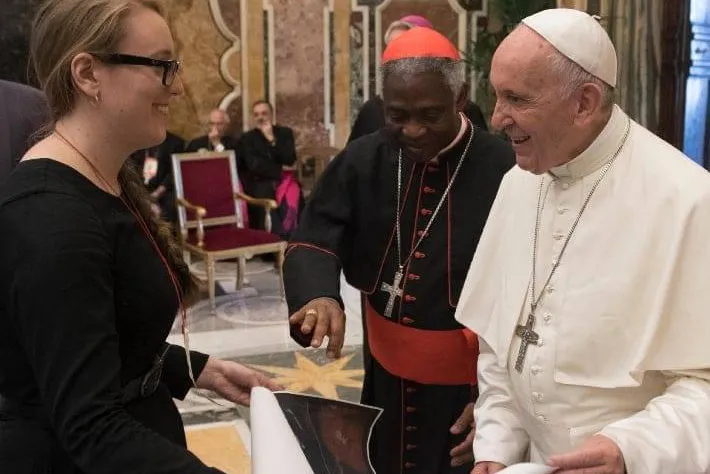
Denver Newsroom, Jan 1, 2022 / 13:00 pm (CNA).
When Molly Burhans met with Pope Francis in 2018, she presented him with a map.
The Catholic Church is one of the largest non-governmental owners of land in the entire world— by one estimate, the Church owns some 177 million acres. That land includes parish churches, cathedrals, hospitals, monasteries, convents, farms, schools, forests…even a few dubiously-purchased apartment buildings.
But a lot of that land isn’t serving the Church’s mission. A lot of it is underutilized, being used for some purpose that’s not ideal, or harming the environment; or, it’s simply gathering dust.
Burhans says one of the biggest reasons for this is that many dioceses and parishes don’t have information at their fingertips about what property they own, let alone plans for what to do with it.
This is one of the reasons that for the past several years, Burhans has been developing interactive electronic maps of the global Catholic Church, with the goal of making the Church more sustainable, and more effective at Her mission.
“I see so much potential”
Burhans says she learned about the power of land early in her life, growing up in Buffalo, New York— a city largely in decline with an abundance of unused space, but a lot of potential, she says.
“I saw that property could change people, transform people and transform communities,” Burhans said.
Burhans committed to her Catholic faith when she was a young adult, and at one point, she even considered religious life. It was while staying at a convent during her discernment process that Burhans saw firsthand the problems, and opportunities, that the Church’s vast land ownership could bring. The convent in question owned a lot of land— vast lawns, forests, buildings— too much really to care for it all in the best way possible.
“I see so much potential. I see that their forest could actually, with a good management plan, could help support them financially,” Burhans recalled.
Burhans didn’t ultimately join the convent, but the lessons she learned about land management stuck with her, and she wanted to help.
While in graduate school at the Conway School in Massachusetts, Burhans figured out how to create an interactive map of over 30,000 land parcels in Portland, Maine, with the goal of protecting urban pollinator habitats. The experience of working on that project got her gears going.
“Wow, we could do this with Catholic property,” she realized. “If I can do this with 30,000 individual parcels, why don’t I do this with a whole diocese’s properties, you know, or a whole religious order?”
Burhans got a pretty fortunate break when the founders of a mapping software company, Esri, offered to give her access to their most sophisticated software package for free to help her start her Catholic mapping project.
Still, at the beginning— in fact, for the first several years— Burhans wasn’t in a position to charge for her services. She did everything pro bono.
Burhans began cold-calling dioceses, offering to map all the properties they owned. Most dioceses she contacted— if they agreed at all— had their property records stored in a dusty box in a basement somewhere, so getting them all in order was a lot of work.
GoodLands’ work in this regard was groundbreaking— surprisingly so. Burhans quickly found that even seemingly simple online maps simply weren’t available, such as a map showing the precise boundaries of each diocese and the diocese’ name.
Burhans had sought out the advice of CARA, a Catholic research group based at Georgetown University in Washington D.C., to see if perhaps they had a digital map of all the U.S. dioceses. All they could offer her, she says, was a PDF that showed all the dioceses of the United States. Nothing interactive, and nothing global.
“There was no global map of anything except for this one on Wikipedia…it was made in Photoshop, pretty much, by a kid who was 16 and had pretty much painted it on. So that was the only global map of the church,” she said, adding that she later hired that “kid” as a paid intern.
By this point, Burhans had assembled a team of cartographers ready to create these maps that she sought. But still, she had her doubts. Surely the Vatican already had a mapping project like this, and maybe they had a good reason not to make the maps public. She didn’t want to reinvent the wheel, or worse, step on Pope Francis’ toes.
“I didn’t want to go ahead with this project first, if the Vatican had it internally; second, if the Vatican had it internally and had good reason that I might not know for not releasing it publicly,” she said.
Turns out, she says…the Vatican didn’t have it. Burhans would have to make the maps herself— and she did.
Why maps?
Today, several years on, along with a team of nearly 3,000 cartographers, Burhans and GoodLands have managed to map almost every single piece of Church-owned property in the United States.
They haven’t made that particular map publicly available, but many of their other maps, containing a wealth of data, are available to view and download on the GoodLands website.
The beauty of mapping out everything the Church owns, Burhans says, is that it allows for better-informed decisions about what to do with the Church’s vast land holdings. It allows the Church’s leaders to better use what they have to further the Church’s mission, she says.
Many dioceses across the country are finding themselves with little choice but to sell off their buildings or land, as their coffers begin to run dry amid declining donations, church attendance, and increasingly, abuse lawsuits.
The data that GoodLands has collected is useful for much more than selling property, however. They’ve gathered a lot of information related to environmental concerns— properties at risk of flooding due to climate change, sea level rises, fire risk, etc.
There’s also a three-dimensional map of Boston with all the buildings and topography included throughout the diocese, mapped with NOAA-based data about sea level rise. They’ve also mapped properties most at risk for earthquakes in Los Angeles.
What’s next?
Burhans met with Pope Francis in 2018, and showed him one of her maps that she had created showing the percentage of Catholics in each diocese of the world. The pope was intrigued; soon after the meeting, he invited her to create a new institute of the Vatican dedicated to map-making, on a six-month trial basis.
If created, this would likely be the first female-founded department at the Vatican. But, ultimately, Burhans turned down that initial offer because it didn’t include any funding. She’s currently working on a proposal for a cartography institute— which she envisions as a “sister institute” to the Vatican observatory— that will, ideally, receive funding from the Vatican.
Obviously, the COVID-19 pandemic has slowed down those plans. But it hasn’t stopped Burhans from garnering more than a half-dozen awards from various organizations, most recently the Sierra Club. Burhans said GoodLands isn’t accepting new clients at the moment, partly because they’ve been inundated with so many requests from dioceses and other Catholic organizations.
Burhans speaks passionately about her hopes that her maps will provoke change in the Church, but she also says she has yet to see her maps move people in the way she hoped. Could a fully-fledged cartography institute at the Vatican change that? It remains to be seen, but Burhans is ready and willing to give it a try.
“A map is worth a million words…This will transform the operations of the Catholic church. I have little doubt,” she said.
A version of this story appeared on Episode 115 of the CNA Newsroom podcast. Click here to listen to the episode.
If you value the news and views Catholic World Report provides, please consider donating to support our efforts. Your contribution will help us continue to make CWR available to all readers worldwide for free, without a subscription. Thank you for your generosity!
Click here for more information on donating to CWR. Click here to sign up for our newsletter.





“Help to heal the earth….”
By the numbers: the 177 million acres of Church holdings are about 270,000 square miles. This is five-hundredths of one percent of the earth’s total land surface at 57.3 million square miles. (The Vatican city-state, at only 109 acres, is 1/6th of one square mile, making it a little over one two-millionth of the total Church land holding.)
Relatively small, the Church’s total acreage, but not without meaning…
While the diminishing Amazon rain forest, for example, is ten times as great (at 2.6 million square miles), ecological stewardship of the Church’s land budget (beyond other kinds of budgets!) could serve as an institutional micro-example of what might/must be done globally to reverse the loss of the earth’s and humanity’s critical resource base, like its forested “lungs” in the Amazon and other tropical areas.
Then the only other problem left for the Church is healing the world’s, yes, interrelated and incommensurate loss of spirituality, morality and souls! The 19th-century Pope Pius IX once said that all the railroads in Italy aren’t worth a single human soul. Likewise, today, “save a tree” is not enough.